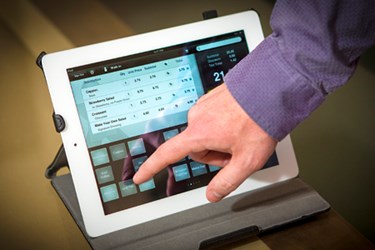mPOS Terminals Industry To See Good Times Ahead
By Shravan Deshmukh

With the gradual replacement of hard cash with virtual currency in an era of digital disruption, mobile POS terminals market has rapidly gained traction in the electronics space. One of the most prominent drivers responsible for the growth of this vertical is the increasing realization among businesses that using cash is a highly expensive option. Businesses, especially those in the tight margin retail industry, have come to realize how cost efficient mPOS terminals can be in addition to contributing toward a more fulfilling customer experience.
Currently, close to $17 trillion transactions are still cash and check based, therefore it is obvious that cash or paper checks are nowhere near to being extinct anytime. Nonetheless, experts have come to acknowledge that using mPOS terminals can revolutionize myriad end-use domains, and mobile POS terminals market in response to this massive adoption rate is likely to register a significant growth rate in the ensuing years.
Government efforts to accelerate and promote cashless transactions through digital payments serve as a key driving factor for mPOS terminal market growth. For instance, in 2016, the demonetization in India resulted in the conversion of payment modes from cash-based payments into card transactions. In addition, the universal acceptance and transition toward EMV (MasterCard, Visa, EuroPay) chip card aids in improving the reliability and security of a cashless transaction. A Federal Reserve study across the U.S. estimated that over USD 178 trillion non-cash payments were made in the country in 2015. The rise in the number of cashless transactions is expected to serve as a key driving force for the global mPOS terminals market.
As the payment landscape continues to evolve, the presence of an omni-channel is becoming much more of a reality and can become one of the determining factors for the future growth potential of a business. Mobile POS is the natural next step in a multi-channel payment distribution system to provide customers with a seamless shopping experience across all retail networks. The methodology offers a tangible approach for retailers to create points of connection with customers at the right time and place to build a more robust relationship. In fact, one study noted a 42 percent rise in sale in enterprises using mPOS than enterprises that do not use mPOS. A report from Global Market Insights, Inc., claims the mobile POS terminals market size is anticipated to surpass $55 billion by 2024.
The Research Study Of Mobile Point Of Sale (mPOS) Terminals Further Segmented Into Solution, Deployment And Application
Solution is classified into Hardware [Handheld Terminal, Tablet], Software. The retail industry has been one of the major consumers for mobile POS terminals market, as smartphones and tablets are becoming increasingly ubiquitous and are being more rapidly used by retailers all over the world. This spurt in mobile usage has commenced to not only provide customers with easier payment options but also to compete with digital giants who have been, for a while now, gaining a substantial proportion of the retail industry share. Google swept the headlines when its digital payment platform Google Pay was launched. Under the latest rollout, Contis, a leading end-to-end provider of banking, processing and payment solutions in U.K. and Europe, also has announced that it is working with Google Pay to offer more customers innovative ways to pay. The company has integrated Google Pay into its end-to-end platform that processes payments in real-time. The incidences thus validate the extensive contribution of the retail sector toward mobile POS terminals industry share.
Deployment is classified into On-Premise, Cloud-Based. Technology always has been a key enabler of advancements across the finance-oriented industry verticals. Mobile POS terminals market is probably one of the largest recipients of the transformed payment landscape. The pay-tech revolution is allowing modern digital payment modes to address payment efficiency, speed, risk detection as well as user experience, providing SMEs the access to tailor their operations in sync with the latest advancements. In this regard, cloud based mobile POS terminals industry is gaining a mass popularity across the globe primarily on account of its enlarged storage facility, ease of operation, and better functionality. Incidentally, this has encouraged a host of new vendors to include SaaS-based solutions in their offerings like Toast, Square, Springboard Retail, and Touchbistro.
Application is classified into Entertainment, Healthcare, Hospitality, Restaurant, Retail. The retail industry has been one of the major consumers for mobile POS terminals market, as smartphones and tablets are becoming increasingly ubiquitous and are being more rapidly used by retailers all over the world. This spurt in mobile usage has commenced to not only provide customers with easier payment options but also to compete with digital giants who have been, for a while now, gaining a substantial proportion of the retail industry share. Google swept the headlines when its digital payment platform Google Pay was launched. Under the latest rollout, Contis, a leading end-to-end provider of banking, processing and payment solutions in U.K. and Europe, also has announced that it is working with Google Pay to offer more customers innovative ways to pay. The company has integrated Google Pay into its end-to-end platform that processes payments in real-time.
